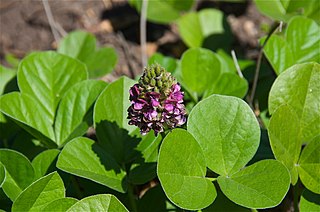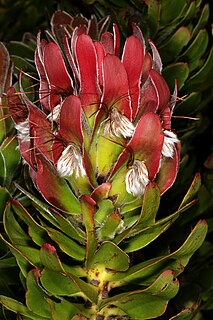
Astragalus trichopodus is a species of legume known by the common name Santa Barbara milk vetch. It is native to southern California and Baja California, where it grows in several types of open habitat, including in the Transverse Ranges and Mojave Desert.

Astragalus asymmetricus is a species of milkvetch known by the common name San Joaquin milkvetch. It is endemic to California, where it grows in grassy and disturbed areas in the Central Valley and nearby parts of the Central Coast Ranges and San Francisco Bay Area.

Astragalus didymocarpus is a species of milkvetch known by the common names Dwarf white milkvetch and Two-seeded milkvetch. It is native to the southwestern United States and northern Mexico, where it can be found in many types of habitat.

Astragalus gibbsii is a species of milkvetch known by the common name Gibbs's milkvetch. It is native to eastern California, the north-central Sierra Nevada, and western Nevada, where it grows in the pine forest habitat of the mountains and the sagebrush of the plateaus.
Astragalus mohavensis is a species of milkvetch known by the common name Mojave milkvetch. It is native to the Mojave Desert of California and Nevada.
Astragalus monoensis is a rare species of milkvetch known by the common name Mono milkvetch. It is endemic to the open pumice plains of central Mono County, California.
Astragalus panamintensis is a species of milkvetch known by the common name Panamint milkvetch.

Astragalus pulsiferae is a species of milkvetch known by the common name Ames's milkvetch. It is native to California and Nevada, and it is known but rare in Washington. It is known from many habitat types, including mountains and plateaus.

Astragalus rattanii is a species of milkvetch known by the common name Rattan's milkvetch. It is endemic to northern California, where it grows in the North Coast Ranges.

Astragalus tricarinatus is a rare species of milkvetch known by the common name triplerib milkvetch, or triple-ribbed milkvetch.

Mimetes hirtus is an upright, evergreen shrub of 1½–2 m high from the family Proteaceae. It has upright, overlapping, (broadly) lance-shaped leaves, without teeth, but with one thickened pointy tip. It has cylindric inflorescences topped by a pine apple-like tuft of pinkish-brownish, smaller and more or less horizontal leaves. The flowerheads are tightly enclosed by yellow, red-tipped bracts, only the 9–14 long red styles and the whitish silky tips of the perianth sticking out. It is primarily pollinated by the Cape sugarbird. It is an endemic species of the southwest of the Western Cape province of South Africa, and grows in wet zones at the base of south facing mountain slopes. Flower heads may be found from May to November, but peaks in July and August. The species has several vernacular names of which marsh pagoda seems to be used most.

Hoita orbicularis is a species of legume known by the common name roundleaf leather-root. It is endemic to California, where it is relatively widespread throughout the state's mountain ranges, growing most often in moist habitat. It is a perennial herb growing prostrate or nearly so at ground level with large leaves each made up of three round leaflets up to 11 centimetres long each. The herbage is glandular and often hairy. The inflorescence is an erect raceme which may be up to 35 centimetres long. Each of the many flowers is one or two centimeters long, pealike, and generally a shade of light to medium purple in color. The fruit is a hairy, veiny legume pod just under 1 centimetre long.
Acmispon argyraeus, synonym Lotus argyraeus, is a species of legume native to California and northwest Mexico. It is known by the common name canyon bird's-foot trefoil. It occurs in dry mountain habitat. It is a perennial herb lined with leaves each made up of a few oval leaflike leaflets about 1 cm long. Most of the plant is silky-hairy in texture. The inflorescence holds one to three pinkish-yellow flowers roughly 1 cm long. The fruit is a dehiscent legume pod up to 2.5 cm long.
Hosackia incana, synonym Lotus incanus, is a species of legume native to California. It is known by the common name woolly bird's-foot trefoil. It is endemic to the Sierra Nevada of California, where it grows in forests and other mountain habitat.
Lupinus affinis is a species of lupine known by the common name fleshy lupine. It is native to the California Coast Ranges from the San Francisco Bay Area north, and into southern Oregon, where it is an uncommon member of the flora in several areas. It is a hairy annual herb growing 20 to 50 centimetres in height. Each palmate leaf is made up of 5 to 8 leaflets each up to 5 centimetres long. The inflorescence is up to 20 centimetres (8 in) long, bearing whorls of flowers each about 1 centimetre long. The flower is purple-blue with a whitish patch on the banner. The fruit is a hairy legume pod up to 5 centimetres (2 in) long containing several seeds.

Hakea denticulata, commonly known as stinking Roger is a shrub tree endemic southern Western Australia. One of the many species of Australian plant described by the botanist Robert Brown. A compact shrub 1–2 m (3–7 ft) high and wide with red flowers in the spring with an unpleasant odour.
Rupertia rigida is a species of flowering plant in the legume family known by the common name Parish's California tea, or Parish's rupertia.

Mimetes fimbriifolius, also called cowl pagoda or the fringed pagoda, is a species of plant in the family Proteaceae. It is a dense, rounded, multi-branched tree that grows up to 4 metres in height. This attractive and striking plant flowers all year round, and produces red and yellow branch-heads and inflorescences. The nectar-rich flowers are pollinated by sunbirds and the seeds are distributed and taken underground by ants before germinating. It is endemic to the Table Mountain range in the city of Cape Town, South Africa.

Vigna owahuensis is a rare species of flowering plant in the legume family known by the common name Oahu cowpea.
Droogmansia megalantha is a plant in the legume family Fabaceae, native to southern tropical Africa.











